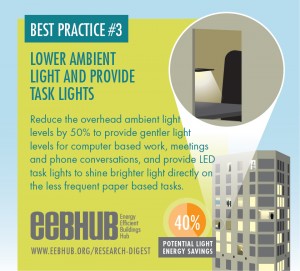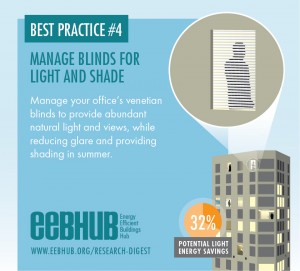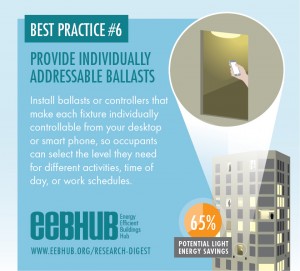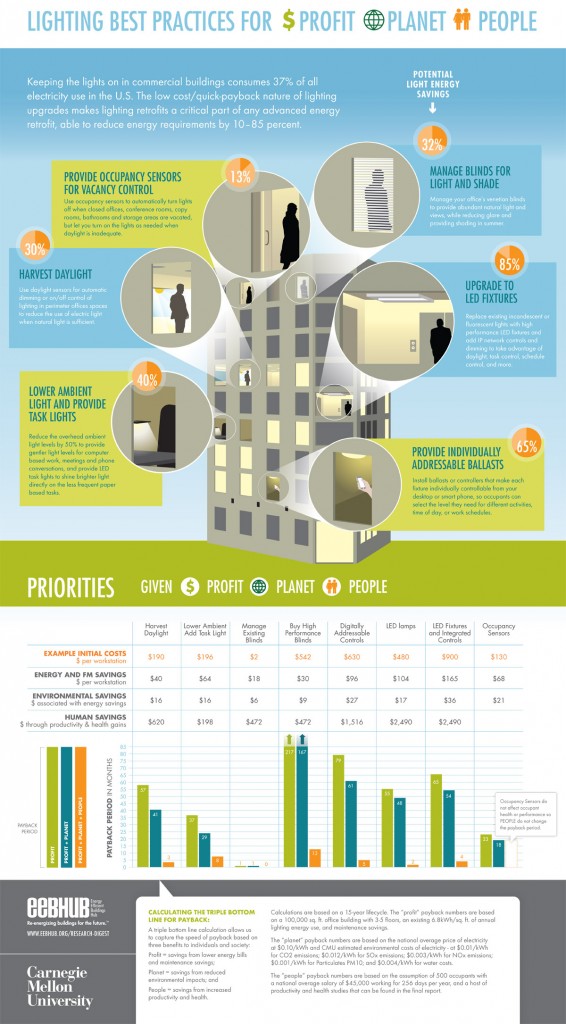Picking the low hanging fruit
You don’t need a 500-lux overhead light to see why the 2009 Pennsylvania Action Plan for Climate Change identified lighting retrofits as one of the most critical methods of minimizing energy use in office buildings, with great carbon-reduction benefits. The US Department of Energy’s 2010 US Lighting Market Characterization report estimated that the commercial sector accounted for 37 percent of all U.S. electricity use. The low-cost/high-payback nature of lighting upgrades makes lighting retrofits the best investments in building upgrades, able to reduce lighting energy requirements by 10-85 percent with the attendant environmental benefits, while also improving employee health and productivity.
CBEI member, Carnegie Mellon University’s Center for Building Performance and Diagnostics (CBPD), identified the best lighting retrofit options for the CBEI region and assessed each upgrade using a “triple bottom line” calculation. The first bottom line calculation captures the hard economic cost-benefits of energy and maintenance savings resulting from each of the six retrofits. The second bottom line captures the environmental cost-benefits that are directly linked to electric energy savings: reductions in CO2, SOX, NOX, particulates, and water demands. These four pollutants represent a majority of the environmental damage from burning fossil fuels to generate electricity and the consequences include respiratory illness, cancers, and developmental impairment. The third bottom line relates to the human health and productivity cost-benefits that are directly linked to improved lighting quality.
By including the environmental and human impacts when calculating the return on investment for each lighting retrofit, the CBPD demonstrated how cost-effective six lighting upgrades can be: increasing business profitability; lowering energy use and pollutant emissions; and improving employee health and productivity. The practices are listed in order from lowest to highest initial cost.
 1. Install occupancy/vacancy sensors for closed spaces
1. Install occupancy/vacancy sensors for closed spaces
An update of the well-known occupancy sensor, vacancy sensors and switches automatically turn lights off when closed spaces are vacated, creating a sustained reduction in both energy cost and energy use that mirrors the actual utilization of the space. According to a US DOE survey, 60 percent of office buildings remain lit after business hours. Even during business hours, 25 percent of the floor area in most office spaces is enclosed space – closed offices, conference rooms, copy rooms, bathrooms, and storage areas – and 40 percent of that space is only sporadically used (occupied only 10-70 percent of the time) [1]. Based on the aggregate findings of three studies, installing these sensors in enclosed rooms will result in an average lighting energy savings of 50 percent in enclosed spaces [2][3][4].
 2. Install daylight harvesting for perimeter lights
2. Install daylight harvesting for perimeter lights
“Daylight harvesting ” is the practice of maximizing the use of daylight to provide lighting to interior building spaces. By installing sensors for dimming or on/off control of perimeter lights, electric lighting can be reduced whenever daylight is available. Daylight sensors that automatically dim lights in response to available daylight offer impressive energy savings, averaging 30 percent [1][5]. Equally important, the shift to daylight as the dominant light source impacts workers’ productivity. In a field study at a software development company, Figueiro et al. identified a 15 percent increase in time dedicated to visual work tasks in daylit workspaces; assuming visual work tasks constitute 25-30 percent of time spent at work, the productivity improvement is 3.75 percent [6]. In a separate field study, Thayer identified a 15 percent reduction in absenteeism among workers with access to daylight [7].
 3. Decrease ambient light levels and add task lights
3. Decrease ambient light levels and add task lights
Since our work today is mostly computer, meeting- and phone-based, instead of paper-based, we need less than half of the 500-600 lux of light provided in today’s office buildings (ASHRAE 90.1-2010). Lighting energy can be reduced by over 40 percent by lowering the ceiling light intensity and offering each worker an adjustable, 6-8 watt LED task light for their paper-based reading and writing tasks. This shift in lighting sources improves employee comfort and satisfaction, and offers health and productivity benefits, as well. Çakir and Çakir, in a multiple building study, recorded a 19 percent reduction in headaches for workers with separate task and ambient lighting as compared to workers with ceiling-only combined task and ambient lighting [8]. Nishihara et al., reported an 11 percent improvement on tasks such as triple-digit multiplication when subjects could control their light levels with task lights [9][10].
 4. Manage blinds for daylight, shade, and views without glare as well as for heat exchange control at night
4. Manage blinds for daylight, shade, and views without glare as well as for heat exchange control at night
Well-designed, well-managed venetian blinds can provide employees with abundant natural light and can help reduce energy use for both heating and cooling. By tilting blinds at a 45° angle, employees can maintain natural light while avoiding glare and overheating in summer. By closing blinds at night in winter, employees can reduce heat loss through windows. In fact, proper installation and operation of venetian blinds can reduce energy use for lighting by 54 percent and energy use for cooling by 32 percent [11][12]. In addition, venetian blind management can also improve performance at visual tasks up to 3 percent due to daylighting, as revealed in two field studies [13][14]. Managing blinds to provide sustained views was found to improve Average Handling Time by 6.7 percent for call center employees seated with visual access to outdoor vegetation, as compared to employees with no view of the outdoors [15]. Finally, in a 1994 study, Romm and Browning identified a 15 percent reduction in absenteeism among occupants in daylight workspaces. The impacts across these studies are represented in the third bottom line [16].
 5. Install individually addressable ballasts with automation
5. Install individually addressable ballasts with automation
Installing addressable ballasts and an automated, high-efficiency lighting control system (e.g. DALI, Encelium, Lutron) allows for optimal daylight usage, task-appropriate lighting levels, and maximized occupancy and vacancy controls. Today, building managers can replace outdated T-12 lamps and PCB -contaminated magnetic ballasts with T-8 or T-5 lamps and digitally-addressable electronic ballasts [17]. This is a “first-cost-intensive” retrofit, because the digitally addressable DALI ballasts must be of a high quality: continuously dimmable from 100% to 10% with no parasitic energy demands when off and supported by an automated control system. However, the average energy savings of the installed system is 65 percent [18][19]. In addition, there are human health and productivity benefits. Wilkins et al. identified a 74 percent reduction in the incidence of headaches among office workers when high frequency electronic ballasts replaced magnetic ballasts [20]. Further, the National Lighting Bureau found a 3 percent increase in individual productivity as a result of upgrading to a high-efficiency lighting system, while Romm and Browning saw a 13 percent increase in productivity and a 25 percent reduction in absenteeism following a lighting retrofit with high-efficiency ballasts, T-8 fluorescent lamps and parabolic louver fixtures [16][21].
 6. Install “vertically integrated” LED light fixtures (lamp, ballast, fixture) plus lighting automation that includes daylight harvesting, dimming and task controls
6. Install “vertically integrated” LED light fixtures (lamp, ballast, fixture) plus lighting automation that includes daylight harvesting, dimming and task controls
The final retrofit recommendation involves replacing existing 2’x4’, 1’x4’, or 2’x2’ troffers containing T12 or T8 lamps with “vertically integrated” LED light fixtures with individual control capability to respond to daylight, occupancy, task, and user preferences. The quality of the LED fixtures is crucial to achieving the best possible results: the LED lamps should have correlated color temperature between 2600K and 3500K, and 90 or more points on the Color Rendering Index . While the market may consider LED fixtures and IP addressable controllers more expensive, field data reveals up to 85 percent energy savings compared to older T12 installations designed to deliver the same light levels [22][23]. In addition, the introduction of LED lights in the proper color range can provide human benefits. Hawes et al. identified an 8.3 percent improvement in worker performance at visual and cognitive tasks with the introduction of LED lighting with high color temperature and adequate illuminance levels [24]. Aaras et al. identified a 27 percent reduction in the frequency of headaches in computer workers when conventional downlighting was replaced by user-controlled suspended indirect-direct lighting [25].
Businesses will have to prioritize investments based on the condition of existing lighting and available capital. However, field data reveals consistently that any investment in lighting upgrades will pay off, as lighting is the most strategic way to conserve energy and to improve the visual conditions for task performance and occupant health. The benefits to employees and the environment bring long-term rewards that more than compensate for initial investments.
References
[1] U.S. Department of Energy, Energy Information Administration. (2003). 2003 Commercial Building Energy Consumption Survey. Retrieved from http://www.eia.gov/consumption/commercial/data/2003/
[2] Mahdavi, M., Abdolazim, M., Elham, K., & Lyudmila, L. (2008). Occupants’ operation of lighting and shading systems in office buildings. Journal of Building Performance Simulation, 1(1), 57-65. doi: 10.1080/19401490801906502 http://www.tandfonline.com/doi/abs/10.1080/19401490801906502#.Uh9tTJLVB30
[3] Maniccia, D., B. Rutlege, M.S. Rea and W. Morrow. (1998). Occupant use of manual lighting controls in private offices. In IESNA (Ed.), Illuminating Engineering Society of North America 1998 Annual Conference: Proceedings (pp. 490-512). New York, NY: IESNA. Retrieved from http://www.lrc.rpi.edu/resources/pdf/34-1998.pdf
[4] U.S. Environmental Protection Agency. (1996). Occupancy Sensor Control in Commercial Office Space (Report No. 430-F-96-053). Retrieved from http://www.cleanaircounts.org/resource%20package/A%20Book/EE%20Lighting/EPAGLap_ocsn3.pdf
[5] Lee, E. S. & Selkowitz, S. E. (2006). The New York Times Headquarters Day lighting Mockup; Monitored performance of the day lighting control system. Energy and Buildings, 38, 914–929. Retrieved from http://sites.energetics.com/buildingenvelope/pdfs/56979.pdf
[6] Figueiro, M., Rea, M., Stevens, R., & Rea, A. (2002). Daylight and Productivity: A Field Study. In ACEEE (Ed.), 2002 ACEEE Summer Study (on Energy Efficiency in Buildings) Proceedings (Panel 8, Paper 6). Pacific Grove, CA: ACEEE. Retrieved from http://aceee.org/proceedings-paper/ss02/panel08/paper06
[7] Thayer, B. M. (1995). Daylighting & Productivity at Lockheed. Solar Today, 9(3), 1995, 26-29. Retrieved from http://www.bristolite.com/Interfaces/media/Lockheed%20Martin%20Productivity%20Study%201983.pdf
[8] Çakir, A. E. (1991). Light and Health: Influences of Lighting on Health and Well-being of Office and Computer Workers. Berlin, Germany: Ergonomic Institut für Arbeits- und Sozialforschung. Retrieve from http://www.healthylight.de/Light_and_Health/Start.html
[9] Nishihara, N., Nishikawa, M., Haneda, M., & Tanabe, S. (2006). Productivity with Task and ambient lighting system evaluated by fatigue and task performance. In ISIAQ (Ed.), Proceedings, Healthy Buildings 2006, Lisboa, Portugal (pp. 249-252). Lisboa, Portugal: ISIAQ. Retrieved from http://www.bsria.co.uk/information-membership/information-centre/library/item/productivity-with-task-and-ambient-lighting-system-evaluated-by-fatigu-jun-2006/
[10] Schwartz, B. S., Stewart, W. F., & Lipton, R. B. (1997). Lost Workdays and Reduced Work Effectiveness Associated with Headache in the Workplace. Journal of Occupational and Environmental Medicine, 39(4), 320-327.Retrieved from http://journals.lww.com/joem/Abstract/1997/04000/Lost_Workdays_and_Decreased_Work_Effectiveness.9.aspx
[11] Lee, E. S., Di Bartolomeo, D. L., & Selkowitz, S. E. (1998). Integrated Performance of an Automated Venetian Blind/ Electric Lighting System in a Full Scale Private Office, Paper presented at the ASHRAE/DOE/BTECC Conference, Thermal Performance of the Exterior Envelopes of Buildings VII, Clearwater Beach, FL. Retrieved from http://gaia.lbl.gov/btech/papers/41443.pdf
[12] De Carli, M. and De Giuli, V. (2009). Optimization Of Daylight In Buildings To Save Energy And To Improve Visual Comfort; Analysis In Different Latitudes. Paper presented at the Eleventh International IBPSA Conference, Glasgow, Scotland. Retrieved from http://www.ibpsa.org/proceedings/BS2009/BS09_1797_1805.pdf
[13] Zhang, Y.; and Altan, H. (2011): A comparison of the occupant comfort in a conventional high-rise office block and a contemporary environmentally-concerned building: Building and Environment; 46 (2), pp. 535-545. Retrieved from http://www.sciencedirect.com/science/article/pii/S0360132310002714
[14] Osterhaus, W. and Bailey, I. (1992): Large Area Glare Sources and Their Effect on Discomfort and Visual Performance at Computer Workstations: 1992 IEEE Industry Applications Society Annual Meeting; Houston, TX: LBL-35037. Retrieved from http://gaia.lbl.gov/btech/papers/35037.pdf
[15] Heschong, Mahone Group, Inc. (2003) Windows and Offices : A study of office worker performance and the indoor environments, California Energy Commission Technical Report. Retrieved from http://www.energy.ca.gov/2003publications/CEC-500-2003-082/CEC-500-2003-082-A-09.PDF
[16] Romm, J. J., and Browning, W. D. (1994). Greening the Building and the Bottom Line: Increasing Productivity Through Energy-Efficient Design. Rocky Mountain Institute, (pp.1-15). Retrieved from http://www.rmi.org/Knowledge-Center/Library/D94-27_GreeningBuildingBottomLine
[17] U.S. General Services Administration. (2009). The New Federal Workplace: A Report on the Performance of Six WorkPlace 20•20 Projects. Retrieved from http://www.gsa.gov/graphics/pbs/GSA_NEWWORKPLACE.pdf
[18] Staff writer. (2000, February 3). Reynolds Saves Over 85% in Energy Costs, Improves Lighting Quality. EDC Magazine. Retrieved from http://www.edcmag.com/articles/reynolds-saves-over-85-in-energy-costs-improves-lighting-quality
[19]Lee, E. S. & Selkowitz, S. E. (2006). The New York Times Headquarters Day lighting Mockup; Monitored performance of the day lighting control system. Energy and Buildings, 38, 914–929. Retrieved from http://sites.energetics.com/buildingenvelope/pdfs/56979.pdf
[20] Wilkins, A. J., Nimmo-Smith, I., Slater, A. I., & Bedocs, L. (1989). Fluorescent lighting, headaches and eyestrain. Lighting Research and Technology, 21(1), 11-18. Retrieved from http://lrt.sagepub.com/content/21/1/11.abstract
[21] National Lighting Bureau. (1988) High Benefit Lighting: Federal Building and Courthouse Save Taxpayers Money. Retrieved from http://www.nlb.org/publications/csh_federal.html
[22] DesignLights Consortium. (2003). 75 North Beacon Street: A Knowhow Case Study. Retrieved from http://www.designlights.org/downloads/75%20N%20Beacon%20St.%20DLC.pdf
[23] Meyers, A. (2009, July 15). Use of LED fixtures in Healthcare Facilities. M+NLB: Mazzetti, Nash, Lipsey, Burch. Retrieved from http://www.mazzetti.com/images/uploads/LED.pdf
[24] Hawes, B. K., Brunye, T. T., Mahoney, C. R., Sullivan, J. M., & Aall, C. D. (2012). Effects of four workplace lighting technologies on perception, cognition and affective state. International Journal of Industrial Ergonomics, 42(1), 122-128. Retrieved from http://dx.doi.org/10.1016/j.ergon.2011.09.004
[25] Aaras, A., Horgen, G., Bjorset, H., Ro, O., and Thorsen, M. (1998) Musculoskeletal, Visual and Psychosocial Stress in VDU Operators Before and After Multidisciplinary Ergonomic Interventions. Applied Ergonomics, pp. 335-354. Retrieved from http://www.ncbi.nlm.nih.gov/pubmed/9703348
